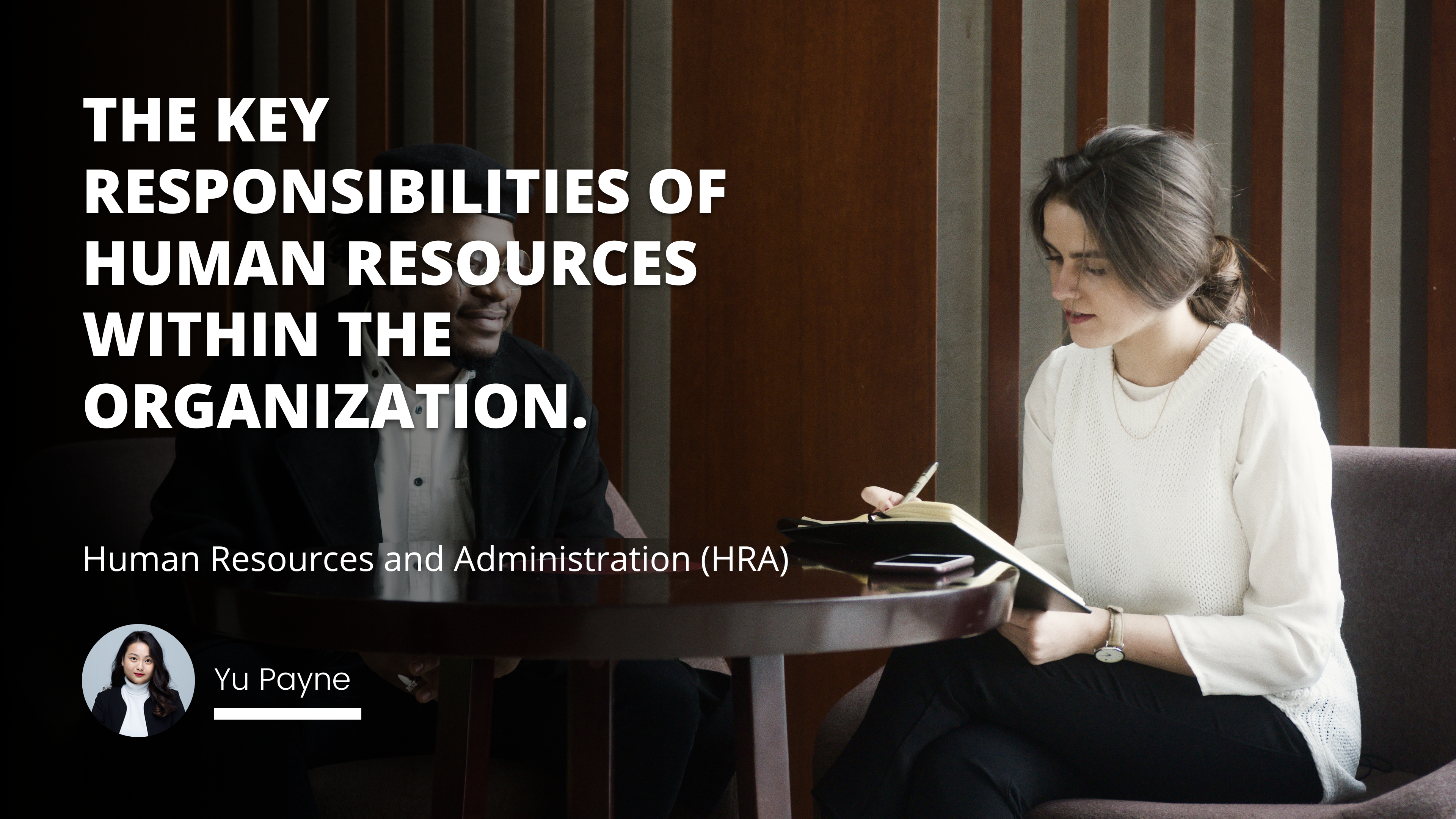
Functioning as a company's backbone, the Human Resources and Administration (HRA) Department is vital to any organization. The HRA Department oversees many essential aspects of the company, from payroll and employee benefits to HR strategy and policy development. Therefore, to ensure your company runs smoothly, it is necessary to have a well-functioning HRA Department in place.
In this blog post, we will discuss the critical functions of an HRA Department and provide tips on how to create an effective one. We will also outline some best practices for maintaining a healthy workplace culture. Then, read on for helpful insights into human resources and administration!
What is human resources and administration (HRA)?
Human Resources and Administration (HRA) is an umbrella term for many services that keep a business running smoothly. It encompasses everything from recruitment and employee relations to managing payroll and collecting taxes. By spending time in these areas, companies can ensure that their employees are safely and fairly treated according to legal and company standards.
Companies with dedicated HR departments value the role of HRA in creating cohesive work environments; HR departments are also responsible for setting performance metrics, providing feedback, conducting performance reviews, setting salary scales, and addressing grievances.
HRA also includes less visible essential functions such as maintaining records documentation, filing of reports or documents required by government agencies, arranging relocation services for new hires when needed, managing the Applicant Tracking System used during the hiring process, developing employee policies, ensuring compliance with applicable laws such as those related to safety regulations or benefits packages offered to workers.
In short, Human Resources and Administration is an integral part of any organization's operations; its primary goal is to maintain a safe and fair environment for workers so businesses can thrive.
The role of HR in a company
Human resources play a crucial role in any company's success. From hiring and onboarding to talent management and succession planning, HR departments ensure that an organization has the people and resources it needs to reach its goals.
In addition to overseeing all aspects of recruitment, onboarding, employee performance review, and payroll, HR defines a company's policies and procedures – affecting everything from vacation time to health insurance plans. HR is also responsible for cultivating a positive work culture by promoting collaboration between teams, advocating for workplace diversity, enforcing workplace safety standards, understanding local labor laws, and resolving employee disputes promptly.
With so much responsibility within their scope of duties, it's clear that human resources hold an important position in the success of any business enterprise.
The role of admin in a company
In any company, the role of an administrator is essential. They are responsible for day-to-day operations and ensuring that protocols and goals are followed. Admin personnel help to keep the wheels of a business running smoothly by organizing meetings, managing data, and keeping track of payments.
They also recruit by screening resumes, providing support to hiring managers, setting up interviews, and even conducting background checks. Administrators also often oversee development projects, ensuring that tasks are appropriately assigned, and deadlines remain realistic.
What's more, these professionals can make sure that staff stays organized by taking care of document management and setting up filing systems. It's easy to see why administrators hold such a pivotal place in any company - without them, disorganization would exist, and progress would be stunted. Ultimately, admin personnel is invaluable in keeping businesses productive and compliant with industry regulations. Their importance cannot be overstated!
How to become a human resource or an administrative professional
Many people are drawn to the dynamic and ever-changing human resources or the administrative work world. If you're interested in pursuing a career in this field, there are several steps you can take to get started. First, it's essential to understand human resources management, personnel operations, and workplace law fundamentals.
Other areas you'll need to review include recruiting and selection, payroll and benefits administration, workplace conflict resolution strategies, employee relations strategies, safety and health protocols, and labor relations compliance. It would help if you also had a basic understanding of accounting principles for payroll and budget tracking. A college degree in
Human Resources Management or a related field is often required for professional positions in Human Resources so obtaining one is beneficial but optional. Though certification from an accredited organization is only sometimes necessary for entry-level HR positions, having certification shows potential employers that you have high professional standards and know the most up-to-date HR industry standards. Most important, though, is gaining experience.
Networking is critical as many benefits come from personal connections within an organization's HR team or other professionals with common interests/backgrounds. So be sure to build relationships with experienced professionals along your journey, as they may open doors that would otherwise remain closed.
Familiarity with computer systems used in office settings such as Microsoft Word, Excel, and PowerPoint can be an added advantage when considering how to become an administrator or human resources professional. Working diligently on obtaining these skills will help strengthen your resume when pursuing this career opportunity, so make use of workshops or self-study tutorials available online!
Taking proactive steps like these will give you what you need to get started on a successful track in the dynamic world of human resources or administrative work! With commitment and dedication, any job seeker has what it takes to prosper in such rewarding fields! Good luck!
Common challenges faced by HR professionals and admins
Human Resources professionals and admins face various challenges, but a few are especially common. One is the difficulty of staying abreast of rapidly changing legislation—from local health and safety laws to international regulations—and ensuring that the company goes beyond compliance with best practices.
Another challenge has effective recruiting strategies to ensure the organization has access to the best talent available—which includes planning and forecasting needs based on business goals and finding creative solutions to attract top-level talent. Admins also regularly struggle with managing employee absences due to illness or other factors, which can affect productivity and raise operational costs from hiring temporary replacements.
Addressing all these issues requires hard work and often difficult decisions. Still, HR professionals and admins have the potential to make a positive, lasting impact on their organization through the successful management of these challenges.
Tips for managing people and processes effectively.
Managing people and processes effectively is essential in any workplace, especially as the pace of work continues to increase. A successful manager will create an environment where employees can collaborate and collaborate quickly. This means a manager must communicate transparently, set expectations for team members, understand what tasks need to get done, and ensure that all team members are given proper resources.
At the same time, managers should encourage creativity by offering meaningful feedback on projects and providing growth opportunities. Additionally, developing trust with team members is vital through actively listening to their ideas and respecting their opinions.
Finally, it's essential to not only be organized when managing processes but also remain flexible enough to respond quickly to changes in the external environment which might present new challenges or opportunities. Following these tips, managers can manage people and processes effectively while building a successful and productive team.
By now, you should have a good understanding of what human resources and administration are. In addition, you know the different roles HR and admin play within an organization. If you're interested in becoming a professional in either field, we can help you take your career to the next level with our HR management course. In this course, you will learn how to manage people and processes effectively and overcome some of the common challenges faced by HR professionals and admins. So if you're ready to start your journey toward becoming a successful HR or admin manager, sign up for our course today!
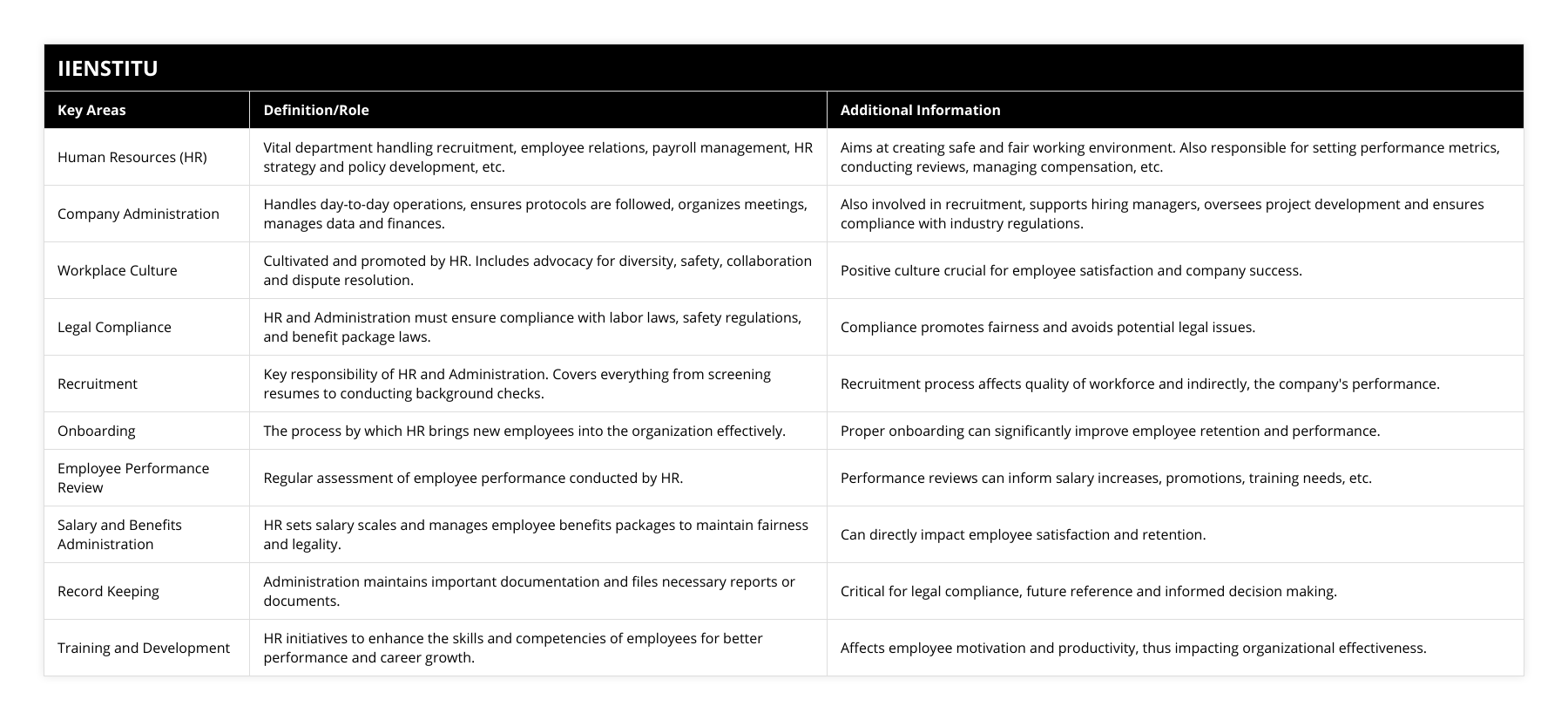
Frequently Asked Questions
What are the key responsibilities of Human Resources in the organization?
The key responsibilities of Human Resources in an organization typically include:
Recruiting and hiring staff.
Administering employee benefits.
Ensuring compliance with state and federal labor laws.
Developing and implementing HR policies and procedures.
Managing employee relations and resolving disputes.
Overseeing employee training and development.
Developing performance management systems.
Managing payroll and benefits.
Supporting organizational development initiatives.

How can Human Resources and Administration help improve employee engagement and motivation?
Human Resources and Administration can help improve employee engagement and motivation by providing employees with the resources, tools, and support they need to succeed in their roles. This includes providing employees with access to development and training opportunities, setting clear expectations and goals, fostering an environment of open communication and feedback, offering recognition and rewards for exceptional performance, and promoting a healthy work-life balance. Additionally, HR and Administration can work to create a culture of engagement and motivation through activities such as team building and employee appreciation events.

What strategies can be implemented to ensure HR compliance with applicable laws and regulations?
Establish written policies and procedures that are in compliance with applicable laws and regulations.
Offer comprehensive training and education on the applicable laws and regulations to HR personnel.
Utilize technology, such as HR software, to automate tracking of employee data and ensure regulatory compliance.
Perform regular reviews and audits of HR processes and procedures to ensure compliance.
Establish a reporting system for employees to report any potential non-compliance to HR.
Create a culture of compliance that is reinforced by upper management and communicated to all employees.

What does HRA mean in human resources?
Definition of HRA in Human Resources
HRA stands for Human Resource Accounting, a term referring to the measurement and reporting of the value of human resources in an organization. In human resource management, HRA seeks to quantify the value of employees, as they are vital contributors to an organization's success.
Importance of HRA in Organizations
HRA plays a crucial role in assisting companies to make well-informed decisions related to their workforce. By assigning monetary values to employees, organizations can effectively evaluate their contributions, thereby improving the overall management of human resources. Additionally, HRA assists in assessing the success of employee training programs, ensuring a better return on investment in these initiatives.
Methods of HRA
There are various methods to conduct HRA, which can be broadly classified into two categories: cost-based and value-based. Cost-based methods, such as historical cost, replacement cost, and opportunity cost, focus on the investment made in employees, while value-based methods, such as the present value of future earnings and economic value-added approaches, attempt to determine the potential value generated by employees.
Benefits of Implementing HRA
Implementing HRA in human resource management offers numerous benefits. For instance, it enables organizations to predict employee turnover and devise strategies to reduce it, as a high turnover rate can have adverse effects on company performance. Additionally, HRA helps identify high-performing employees who bring significant value, ensuring targeted investments in employee development and retention.
Challenges Associated with HRA
Despite its many advantages, HRA also presents several challenges. Assigning a monetary value to human resources can be subjective and complex, as each individual has unique characteristics and contributions. The dynamic nature of employee performance further complicates this process. Moreover, ethical concerns may arise while quantifying an employee’s worth in monetary terms, which could potentially dehumanize the workforce.
Conclusion
In conclusion, HRA is an important concept in human resource management that focuses on measuring and reporting the value of human resources within an organization. While it offers various benefits in decision-making and resource allocation, organizations must address the associated challenges to effectively implement HRA policies. Ultimately, proper application of HRA can lead to improved management of human resources and, consequently, greater organizational success.

What is the HRA program in NYC?
Introduction to HRA Program in NYC
The Human Resources Administration (HRA) program in New York City facilitates various services aimed at improving the overall quality of life for its residents. It strives to provide financial assistance, economic security, and vital support through an array of social welfare programs designed to cater to the diverse needs of individuals, families, and communities.
Key Services Offered by HRA
Financial assistance programs are a cornerstone of the HRA's offerings, ensuring that individuals and families receive essential support. Cash assistance, for instance, enables eligible individuals and families to meet their basic needs, while the Supplementary Nutrition Assistance Program (SNAP) makes sure they have access to nutritious food. Additionally, emergency food assistance is always available for those in critical need of sustenance.
Healthcare Assistance and Resources
The HRA also addresses healthcare needs by providing comprehensive medical insurance, including benefits through programs such as Medicaid and the NYC Care program, which offer assistance to adults and children alike. Through these programs, individuals gain access to vital medical services, including preventive care, emergency care, and prescription medications.
Employment Support and Opportunities
Understanding the importance of self-sufficiency and gainful employment, the HRA program further offers a range of employment services. The agency assists in connecting job seekers, particularly those within the cash assistance program, with suitable employment opportunities that help them achieve personal and economic stability. Additionally, the agency provides support services like vocational training and work readiness programs for individuals seeking to enhance their employability and future prospects.
Housing Stability and Support
Another critical aspect of the HRA program is addressing the housing needs of NYC residents. The agency administers emergency rental assistance programs that provide temporary financial aid for those struggling with rent payments. It maintains a Homelessness Prevention Program designed to offer legal and financial supports for individuals at risk of eviction.
Child Support Services
The HRA program also helps in ensuring child support obligations are fulfilled, providing assistance to both custodial and non-custodial parents to facilitate and enforce child support payments. This assistance includes efforts to locate non-custodial parents, establish paternity, and modify existing child support orders as necessary.
In conclusion, the Human Resources Administration program serves as a significant social welfare mechanism in New York City, catering to the diverse needs of its residents. Through financial assistance, healthcare resources, employment support, housing stability, and child support services, the HRA helps improve the quality of life for countless individuals, families, and communities across the city.
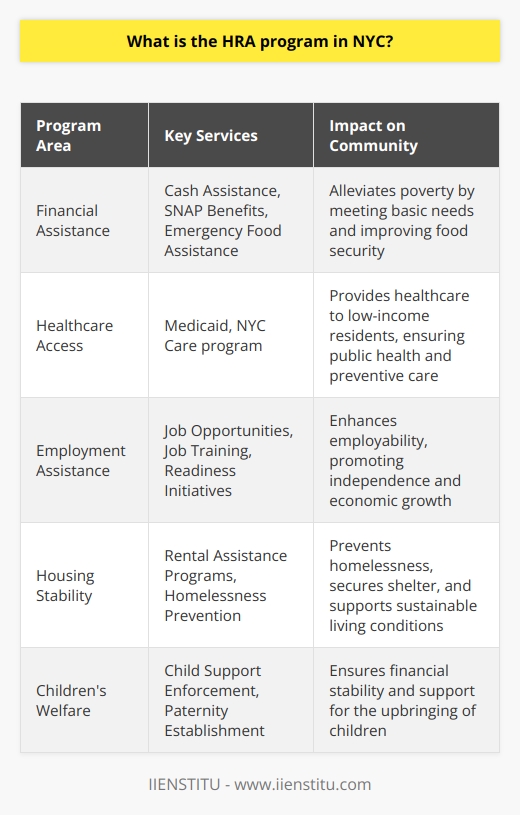
How do I contact HRA access NYC?
Accessing HRA Services in NYC
To contact the Human Resources Administration (HRA) in New York City, one must follow a distinct process that involves accessing the official HRA website, known as Access NYC. Access NYC provides a comprehensive platform to gather information, apply for benefits, and access available services offered by the HRA.
Navigating the Website
Begin by visiting the Access NYC website (www.access.nyc.gov). Here, users can explore various programs and services that cater to their specific needs. The website is user-friendly and includes filters for easier navigation.
Applying for Benefits
Users can also apply for benefits directly through Access NYC. They must create an account to start the application process. After logging in, users can fill out forms and upload necessary documents. The platform hosts applications for numerous programs, including food assistance, child care, and housing support.
Live Chat Assistance
For further guidance and inquiries, Access NYC offers a live chat feature. Agents are available Monday through Friday during normal business hours. They can answer questions about eligibility, required documents, and ongoing applications.
Telephone Support
In addition to online resources, users can contact HRA by calling the HRA Infoline at 718-557-1399. This helpline operates from Monday to Friday, 8 am to 5 pm. Users can gather information, receive application assistance, and ask questions about existing benefits.
Visiting Local Offices
Lastly, individuals can visit HRA offices throughout the city. Office locations are listed on the Access NYC website under the 'Find an HRA Location' section. In-person visits can be beneficial for those with limited internet access or who prefer face-to-face interactions.
In conclusion, contacting HRA Access NYC involves various methods, including utilizing online resources, calling the HRA Infoline, and visiting local offices. By taking advantage of these options, individuals can ensure that they have access to the programs and services provided by the HRA in New York City.
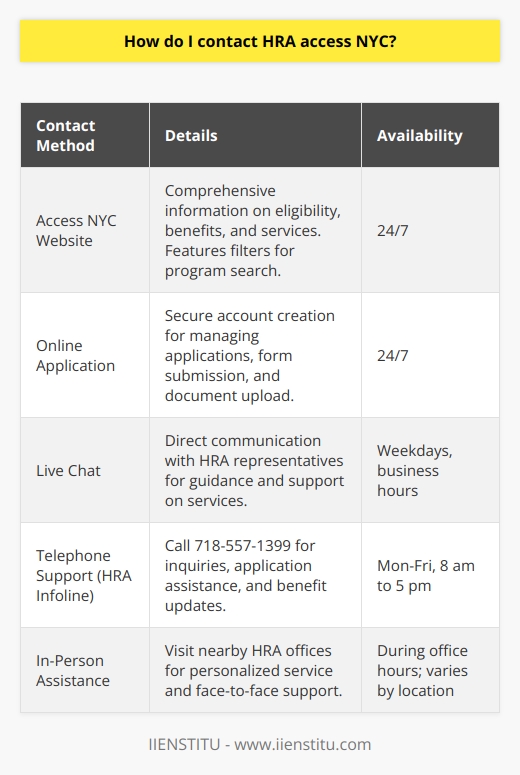
What are the essential functions and objectives of HRA in the context of human resources management?
Understanding HRA Functions and Objectives
The primary function of Human Resource Accounting (HRA) in the context of human resources management is to quantify and evaluate human capital. HRA enables organizations to better understand, manage, and optimize their workforce, strengthening their competitive position in the market. Consequently, the objectives of HRA fall into three main categories: measuring the value of human resources, enhancing decision-making, and improving organizational performance.
Measuring the Value of Human Resources
One essential function of HRA involves the process of quantifying a company's human capital by assigning monetary values to employees' skills, knowledge, and abilities. This measurement helps organizations to accurately assess their total assets, providing valuable insight into the worth of their workforce, and promoting sound investment strategies centered on human resources.
Enhancing Decision-Making
HRA serves as a tool for decision-makers to make well-informed choices with regards to human resource management strategies. By quantifying the value of employees, HRA allows organizations to effectively allocate resources, such as training and development, to capitalize on and improve employees' skills and potential. Additionally, HRA supports human resource planning, aiding in talent acquisition, retention, and succession management.
Improving Organizational Performance
Ultimately, the objectives of HRA aim to bolster organizational performance. By identifying the value of human capital, companies can align their human resource strategies with their overall goals and objectives. This alignment fosters employee engagement and satisfaction, leading to increased productivity, commitment, and loyalty. Furthermore, HRA facilitates workforce optimization, ensuring that employees' skills and contributions are maximized to support the company's strategic direction.
In conclusion, Human Resource Accounting plays a vital role in modern human resources management by measuring the value of human resources, influencing decision-making processes, and enhancing organizational performance. As organizations increasingly recognize the importance of human capital as a pivotal driver of success, the integration of HRA within human resource management strategies will become progressively more critical.

How does the HRA framework contribute to the overall strategic goals and organizational culture of an organization?
Understanding the HRA Framework
The Human Resource Alignment (HRA) framework is a powerful tool that facilitates a comprehensive understanding of an organization's strategic goals and its overall culture. By aligning human resource strategies with the broader objectives of a company, the HRA framework supports the pursuit of optimized performance and competitive advantage.
Strategic Goals and Performance
Achieving organizational strategic goals requires the effective management and alignment of key resources, especially the human capital. Utilizing the HRA framework aids in the identification of the skills, competencies, and attitudes necessary to drive success. Furthermore, it helps organizations create performance management systems that evaluate, develop, and reward employees based on their contribution to these strategic goals.
Organizational Culture and Employee Engagement
An organization's culture, defined by its values, beliefs, and norms, plays a substantial role in shaping employees' behavior and consequently, overall performance. The HRA framework emphasizes the importance of fostering a positive culture that aligns with organizational goals, ensuring that employees are engaged and driven to pursue excellence. This alignment is crucial for unlocking employees' full potential and retaining top talent within the organization.
Knowledge Sharing and Collaboration
Effective collaboration and knowledge sharing are essential components of a high-performing organization. Through the HRA framework, organizations can identify the necessary policies, practices, and infrastructure to encourage collaboration and capitalize on employees' collective intelligence. This not only promotes innovation and creativity but also aids in the continuous improvement of business processes and products.
Leadership Development and Succession Planning
One of the hallmarks of successful organizations is their ability to identify and develop the next generation of leaders. The HRA framework provides a robust methodology for leadership development, considering the diverse skills, experiences, and talents needed to drive the organization towards its strategic goals. Additionally, the framework supports effective succession planning, ensuring that critical leadership positions are filled by capable individuals who are well-prepared to guide the organization forward.
In conclusion, the HRA framework is an invaluable tool for organizations seeking to align their human resource strategies with their overall strategic goals and culture. By facilitating performance management, employee engagement, knowledge sharing, and leadership development, the framework significantly contributes to the long-term success and sustainability of a company.
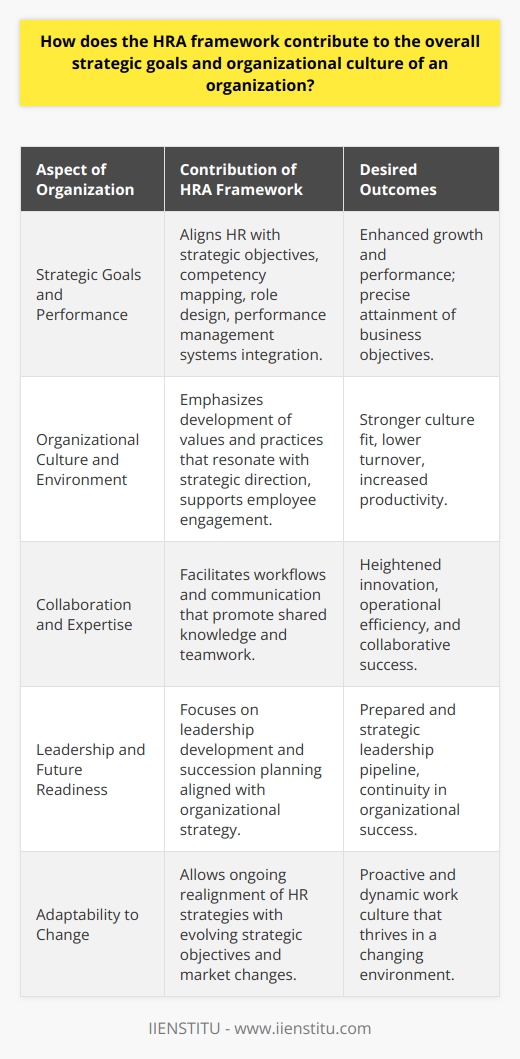
What specific HR practices and policies are shaped by the HRA perspective, and how do they influence workplace dynamics and employee performance?
HR Practices Shaped by the HRA Perspective
The human resource architecture (HRA) perspective shapes several HR policies and practices, playing a critical role in enhancing workplace dynamics and employee performance. One noteworthy practice influenced by the HRA perspective is the design of HR policies tailored to different employee segments, which helps in catering to unique needs and expectations (Lepak & Snell, 2002).
Strategic Workforce Planning
Under the HRA framework, strategic workforce planning allows organizations to align workforce capabilities with business objectives. This practice includes skills analysis, workforce forecasting, and resourcing strategies, which contribute to ensuring that employees possess the competencies required to achieve organizational goals (Lepak & Snell, 2002).
Talent Management
Talent management, another HR practice shaped by the HRA perspective, involves identifying high-potential employees and nurturing their growth through targeted development programs, career planning, and succession management. By fostering a high-performance culture, talent management initiatives enhance employee engagement and overall performance (Collings & Mellahi, 2009).
Performance Appraisal and Feedback
Regular performance appraisal and feedback mechanisms under the HRA perspective ensure that employees receive constructive evaluations on their contributions towards organizational goals. These practices facilitate open communication, promote self-awareness, and enable employees to identify areas for improvement (DeNisi & Pritchard, 2006).
Reward and Recognition Systems
The HRA perspective underscores the importance of designing reward and recognition systems that align with employee expectations and organizational objectives. Such systems can include monetary incentives, non-monetary rewards, and formal recognition programs that acknowledge exceptional performance, thereby motivating employees to excel in their roles (Milkovich, Newman, & Gerhart, 2013).
Organizational Culture and Climate
Lastly, the HRA perspective emphasizes the significance of cultivating an organizational culture and climate that values employee well-being, and fosters collaboration and innovation. By promoting a positive work environment, HR policies and practices can enhance workplace dynamics, employee satisfaction, and overall performance (Denison, 1990).
In summary, the HRA perspective shapes HR practices such as strategic workforce planning, talent management, performance appraisal and feedback, reward and recognition systems, and organizational culture and climate. These practices influence workplace dynamics, employee engagement, and performance, making them vital components for organizations' success.
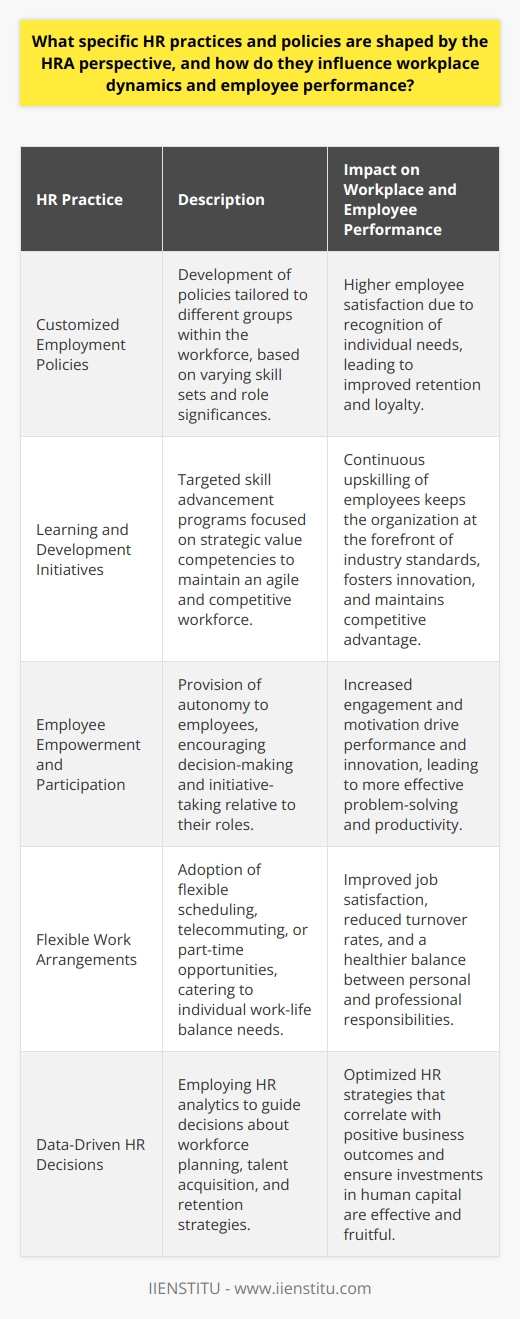
What is the role of Human Resources and Administration (HRA) in the development and implementation of organizational policies and procedures?
Role of HRA in Policy Development
The development and implementation of organizational policies and procedures is a crucial aspect of maintaining a well-functioning organization. One of the key players in this process is the Human Resources and Administration (HRA) department. HRA plays a critical role in several phases of policy development, including drafting, consultation, and communication.
Drafting Organizational Policies
The HRA department is instrumental in drafting organizational policies that promote a healthy work environment and ensure legal compliance. They conduct thorough research to identify existing gaps and develop policies that effectively address these issues. Additionally, HRA ensures that policies are clear, concise, and in alignment with the organization's mission, vision, and values.
Facilitating Consultation
An essential part of developing and implementing effective policies involves receiving input from various stakeholders within the organization. The HRA department plays a pivotal role in organizing and managing consultations, allowing employees to voice their opinions, concerns, and suggestions. This feedback helps to create policies that are tailor-made to the organization's unique needs and ensures a sense of ownership and commitment among employees.
Communication and Training
Once policies and procedures have been developed, it is crucial to communicate these changes effectively to all employees. The HRA department takes responsibility for informing employees about new or updated policies through multiple channels such as announcements, email updates, and internal newsletters. Furthermore, the HRA department is responsible for providing training sessions and resources to ensure employees understand and adhere to the new policies and procedures.
Monitoring and Evaluation
Ongoing monitoring and evaluation are vital to ensuring that organizational policies and procedures remain relevant, effective, and compliant with changing laws and regulations. The HRA department facilitates regular assessments of policies, measuring their effectiveness through key performance indicators, and revising them as necessary.
In conclusion, the Human Resources and Administration department plays a crucial role in the development and implementation of organizational policies and procedures. Their expertise in policy drafting, consultation, communication, and evaluation ensures that policies are well-designed, effectively communicated, and continuously aligned with the organization's goals and objectives.
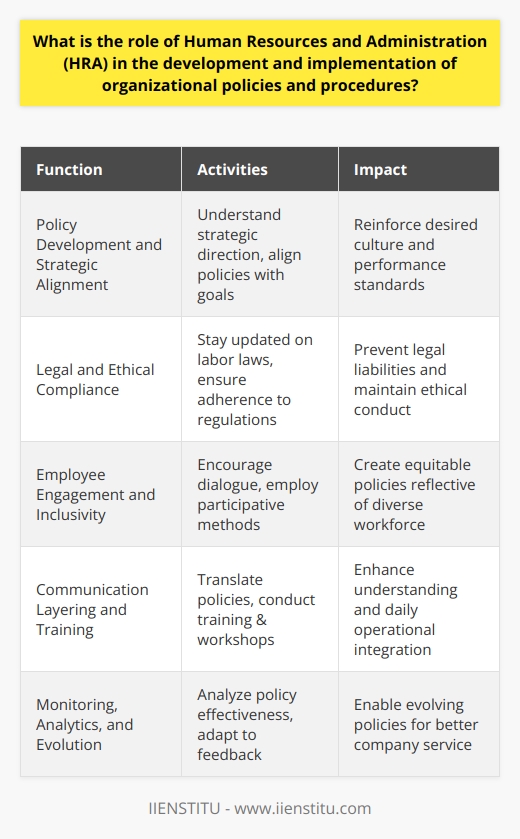
How do various HRA functions interact and collaborate in managing human capital and maintaining a healthy work environment?
HRA Functions Interaction and Collaboration
In managing human capital and maintaining a healthy work environment, various Human Resource Analytics (HRA) functions interact and collaborate to create a holistic approach. HRA functions, at their core, facilitate effective communication among team members, decision-makers, and stakeholders.
Data-Driven Decision Making
Data-driven decision-making is a critical aspect of HRA functions as it helps in developing strategies based on empirical evidence. HRA enables organizations to create and implement policies considering the needs and preferences of their employees, thus fostering more engaged and satisfied personnel.
Performance Management and Appraisal
Performance management and appraisal focus on monitoring and evaluating employees’ performance and providing constructive feedback. This HRA function collaborates with data-driven decision-making by using key performance indicators (KPIs) and other relevant metrics to assess employees’ performance objectively, resulting in rewards and recognition that motivate and inspire employees.
Talent Acquisition and Retention
Talent acquisition and retention are essential HRA functions that ensure organizations attract and maintain the best pool of human capital. These functions collaborate with other HRA functions, such as performance management and data-driven decision making, to analyze and identify factors contributing to employee satisfaction, engagement, and turnover. This information helps HR departments make informed decisions about recruitment, retention initiatives, and employee development programs.
Learning and Development
Learning and development activities are crucial for nurturing employee growth and skill development. HRA functions support these initiatives by conducting data analysis to recognize skill gaps and recommend appropriate training programs. Moreover, HRA functions ensure that employee training aligns with the organization's goals and objectives.
Employee Well-being and Workplace Health
HRA functions also play a pivotal role in promoting employee well-being and maintaining a healthy work environment. By analyzing data, HR professionals identify areas needing intervention, such as workload, stress levels, and work-life balance. Implementing policies and procedures to address these issues ensures employees are happier, healthier, and more productive.
In summary, HRA functions interact and collaborate to ensure organizations manage their human capital effectively and maintain a healthy work environment. By incorporating data-driven decision-making, performance management, talent acquisition and retention, learning and development, and employee well-being initiatives, HRA helps create a proactive and forward-looking HR strategy that contributes to organizational success.

In what ways do Human Resources and Administration practices contribute to employee retention and talent management within the organization?
Organizational Effectiveness through HR and Administration
Human Resources and Administration practices play a vital role in employee retention and talent management within organizations. These practices focus on employee development, engagement, satisfaction, and well-being, leading to a positive work environment that attracts and retains top talent.
Employee Development: Training and Development
Organizations with robust HR and administration practices invest in employee training and development to enhance their skills and abilities. An organization that fosters continuous learning is more likely to retain employees by offering opportunities for professional growth and advancement. This investment also contributes to the workforce's overall competence and competitiveness, enabling organizations to retain the right talent.
Employee Engagement: Performance Management and Recognition
HR and administration practices are instrumental in creating a work culture that engages employees through regular performance management and recognition. When employees feel valued and appreciated for their work, they are more likely to remain loyal and contribute to an organization's success. Performance management systems and recognition programs facilitate feedback and celebrate accomplishments, fostering employee engagement and retention.
Employee Satisfaction: Compensation and Benefits
Competitive compensation and benefits packages are essential for attracting and retaining talent. HR and administration practices ensure that organizations design and implement attractive remuneration packages that reflect market trends and the value employees bring to the organization. Fair and equitable compensation systems signal an organization's commitment to employee satisfaction and contribute to retention efforts.
Employee Well-being: Work-Life Balance
Human Resources and Administration practices consider employees' well-being by promoting work-life balance. Employees who can maintain a healthy balance between their professional and personal lives are generally more satisfied and productive, resulting in a stable and committed workforce. HR policies that support flexible working arrangements, paid leave, and stress management initiatives contribute to employee well-being, retention, and loyalty.
In conclusion, organizations can optimize their employee retention and talent management strategies by investing in robust HR and administration practices. These practices cultivate a positive work environment that promotes employee development, engagement, satisfaction, and well-being, ultimately leading to a high-performing workforce committed to the organization's success.
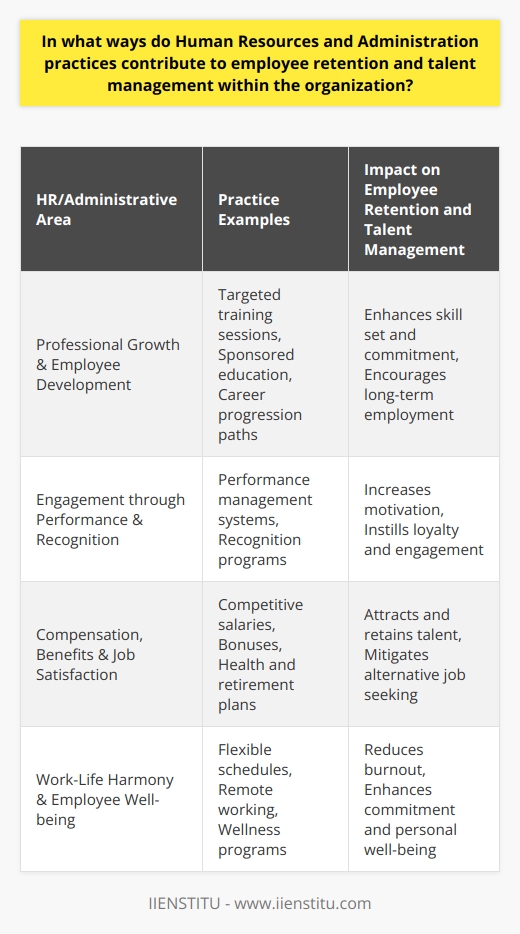
What are the core principles guiding the HRA approach in human resources management?
The Human Resources Accounting (HRA) approach in human resources management rests upon several foundational principles.
Value of Human Capital
First, HRA recognizes that human capital has immense inherent value. The approach views employees not just as costs but as significant assets that drive organizational productivity and profitability.
Investment Perspective
Second, HRA embodies an investment perspective. This acknowledges the upskilling and training of employees as beneficial investments that enhance the organization's overall value, rather than mere expenses.
Quantifying Human Resources
Third, HRA emphasizes the need to quantify and measure human capital. It encourages the organization to assign monetary values to human resources, facilitating comparability with tangible financial assets.
Decision-Making Utility
Fourth, the approach propounds decision-making utility. The accurate numeric evaluations of human capital generated through HRA can greatly aid strategic planning and decision making in organizations.
Responsibility Accounting
Lastly, Responsibility Accounting is a critical underpinning principle of HRA. This encourages individual responsibility by linking both positive and negative human resource outcomes directly to the concerned management.
In sum, the HRA guides the organizations to value, invest in, and quantitatively measure their human capital while promoting informed decision-making and reducing complacency by inculcating a sense of responsibility.
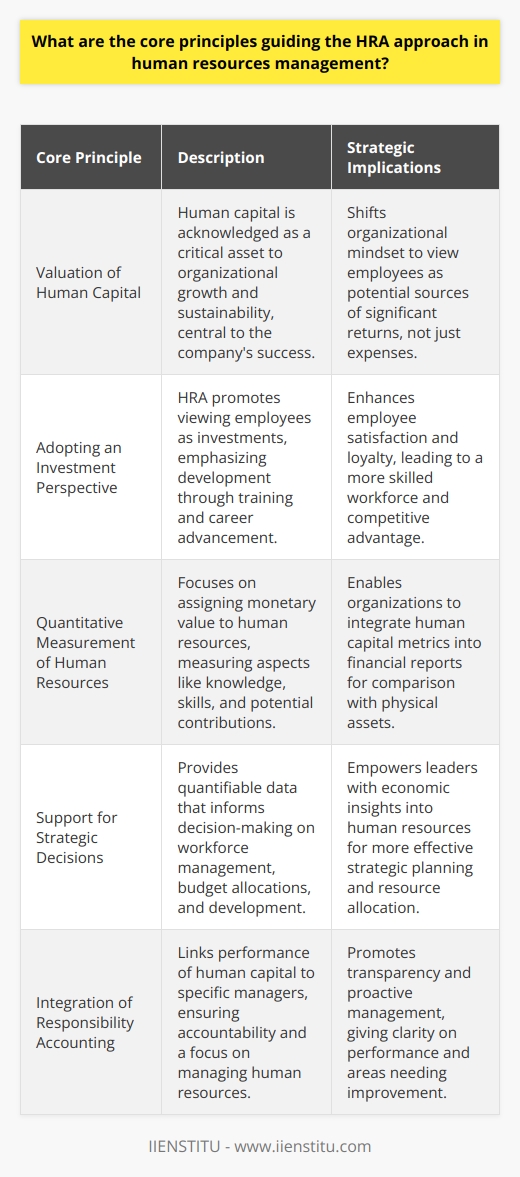
How do HRA practices address the challenges associated with diversity and inclusion in the workplace?
Understanding HRA Practices
Human Resource Analytics (HRA) practices can offer insights into diversity and inclusion (D&I) challenges in the workplace. By leveraging data, HR can effectively manage disparities and promote inclusion.
Role of Data Analysis
Data analysis is a critical aspect of HRA. It provides concrete evidence of inequalities or biases that hinder D&I. For example, HRA can expose gaps in salaries, promotions or skill development opportunities between different demographic groups.
Real-time Diversity Tracking
HRA allows for real-time diversity tracking. It collects data on employee demographics, helping businesses monitor D&I objectives and ensuring balanced representation of different groups.
Inference-Based Decision Making
HRA aids in informed decision making. Analytics reveal discrepancies, identify root causes and suggest remedial measures, facilitating evidence-based D&I initiatives. It ensures that HR decisions are objective and impartial.
Maximizing Talent Pool
HRA practices can help optimize a diverse talent pool. It aids in identifying talent across different groups, supporting unbiased hiring, and enhancing workforce diversity.
Strategizing Employee Retention
Data-driven HRA strategies assist in employee retention. They identify patterns and trends linked to staff attrition, helping to curb unwarranted departures, especially among marginalized groups.
In conclusion, HRA practices using data analytics can address D&I challenges effectively. By delivering insights into imbalances, promoting informed decision-making, and fostering equitability, HRA can significantly contribute to fostering an inclusive work environment.
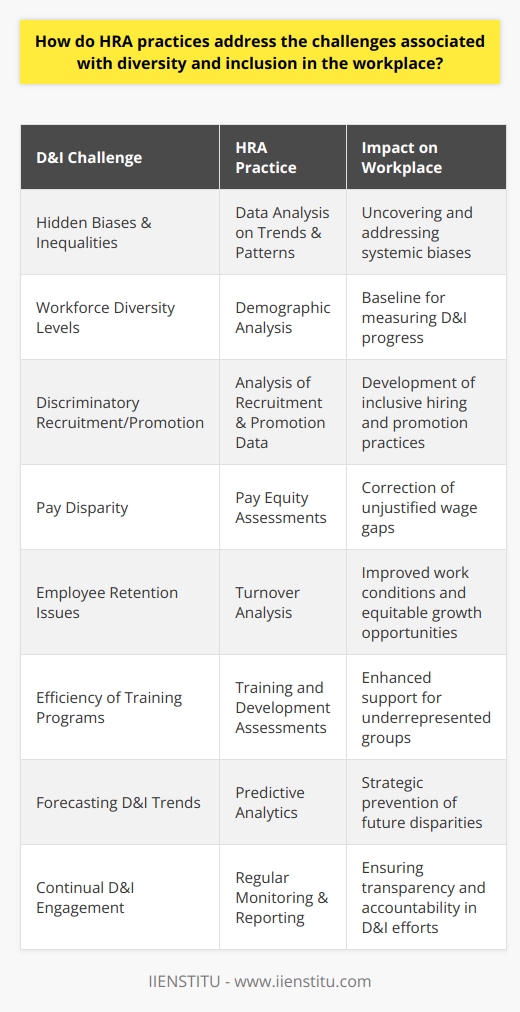
What are the critical success factors and key performance indicators for evaluating the effectiveness of HRA initiatives and interventions within an organization?
Identification of Critical Success Factors
Critical Success Factors (CSFs) are essential elements that contribute to the success and effectiveness of Human Resource Analytics (HRA) within an organization. Notably, leadership commitment, strategic alignment, data quality, and analytical skills stand out as significant CSFs.
Role of Leadership Commitment
Leadership commitment refers to top management's support for the HRA initiative. Without this, employees may not view the initiative as important, potentially reducing its effectiveness.
Importance of Strategic Alignment
Strategic alignment means aligning the HRA initiative with the broader organizational strategy. This ensures that HRA efforts contribute directly to the achievement of organizational goals.
Necessity of Data Quality
Data quality is an imperative CSF as HRA heavily relies on data. The better the data quality, the more reliable and valuable the results will be.
Significance of Analytical Skills
Analytical skills among HR professionals are vitally required to interpret HRA outcomes effectively. Well-trained personnel can leverage HRA tools to derive meaningful insights that drive decision-making.
Understanding Key Performance Indicators
Key Performance Indicators (KPIs) are quantitative measurements of the effectiveness and efficiency of HRA initiatives. Examples include workforce turnover rates, training costs per employee, or employee engagement levels. These indicators help to measure the success of HRA interventions.
In sum, CSFs and KPIs are two fundamental frameworks for evaluating the effectiveness of HRA initiatives within an organization. However, it’s crucial to tailor these factors to the specific context and needs of your organization for an accurate evaluation.



